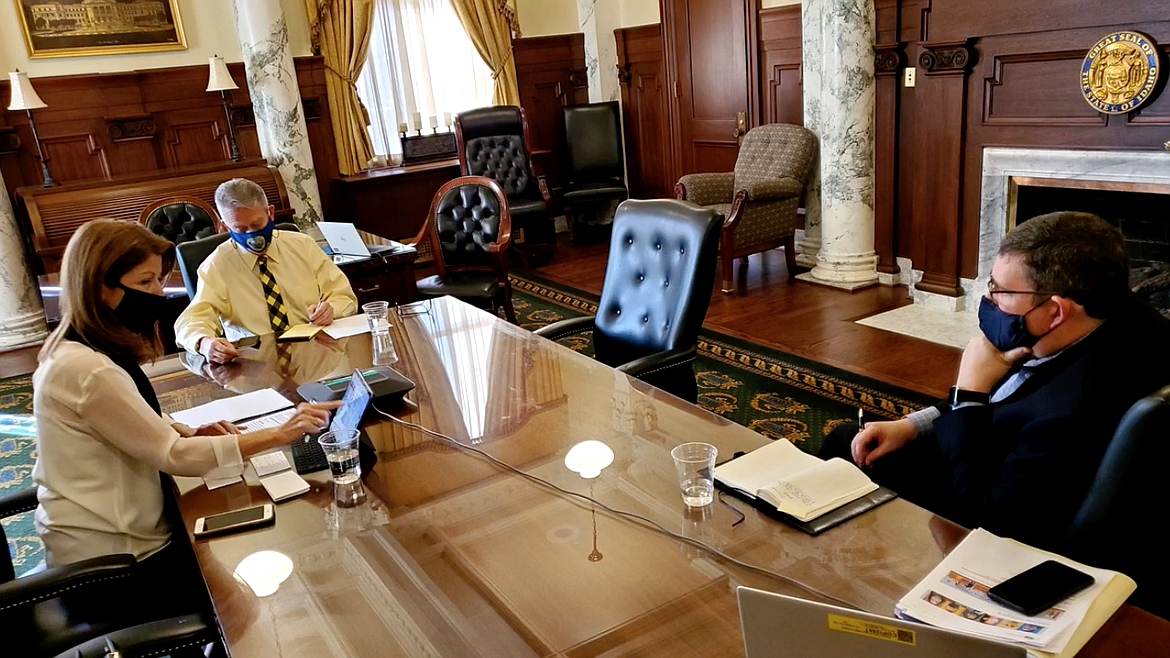Little Administration: 'There will be challenges' distributing vaccine
Gov. Brad Little and members of his COVID-19 response team acknowledged Tuesday that distributing and administering vaccines won’t be simple.
In his weekly AARP-sponsored conference call with Idaho listeners, Little — sitting alongside state epidemiologist Dr. Christine Hahn and Idaho Department of Welfare director Dave Jeppesen — said the first round of at least one of three vaccines could potentially be distributed before the end of the year.
“We’ve got to quit meeting like this,” Little said to start off the conference call. “I look for the day where Dr. Hahn and Director Jeppeson and I don’t have to do this, and I’m also thankful for the fact our modern medical system is going to have a vaccine.”
Pfizer and BioNTech submitted their joint vaccine to the Food and Drug Administration for approval on Nov. 19. Moderna and AstraZeneca filed their FDA Emergency Approval submissions Tuesday, though Moderna admitted setbacks on Tuesday, stating that its vaccine doesn’t prevent the spread of COVID-19. Oxford University in England is also developing a vaccine, reporting Tuesday it had made significant strides in effectiveness rates.
How those vaccines get distributed is another issue entirely.
Pfizer has already produced at least 40 million doses, more than six million of which will roll out in the first round of distribution by the federal government to the 50 states, divided up generally per capita.
The plan, dubbed “Operation: Warp Speed,” calls on states to determine how those vaccines will ultimately reach the hands of its citizens. Idaho’s Vaccine Advisory Committee recommended on Nov. 9 that the state accepts early doses of the vaccine, thus giving Idaho one to two days of early access.
But administering those vaccines comes with complications, ranging from the availability of syringes to suspending rules that prohibit pharmacy technicians from administering shots to tracking reminders for second doses.
“There are all sorts of challenges, as the governor alluded to,” Hahn said. “… I don’t want to downplay it: We will have challenges. Everybody is going to, I think, want (the vaccine) as soon as it’s available. We only have a limited number of people we’re going to vaccinate. There’s going to be challenges, but we recognize that, and I think the fact that it’s ‘all-hands-on-deck’ and everyone working together is going to be incredibly helpful.”
How that vaccine is distributed to the population is still up for debate. Whichever vaccines become available will not fill nearly enough doses for every man, woman and child in America, let alone the world.
Pfizer has said it strives toward 50 million doses globally by the end of the year. AstraZeneca has teased the potential for 200 million doses ready for worldwide distribution by year’s end, with the potential for at least 100 million doses each month after. Oxford predicts it could have three billion doses ready by the end of 2021.
Idaho’s vaccine committee is still determining how the vaccine will be distributed. Jeppesen said the federal government recommends the vaccine gets distributed first to health care workers and workers in long-term care centers, followed by workers in critical infrastructures — such as first responders — and people with underlying health conditions.
“It will be very limited distribution when it first comes out in December,” Jeppesen said. “It will not be the case that everyone that wants a vaccine can run down … to get vaccinated.”
Still, all three expressed optimism about Idahoans seeing not only the first signs of an approved vaccine before Christmas, but of seeing a safe vaccine.
“We need to make sure the vaccine is safe,” Little said, “and we have to get it delivered. We’re working on the delivery here. The federal government — the FDA — is working on making sure it’s safe, and they have told all three of us at various meetings that is their No. 1 priority.”

